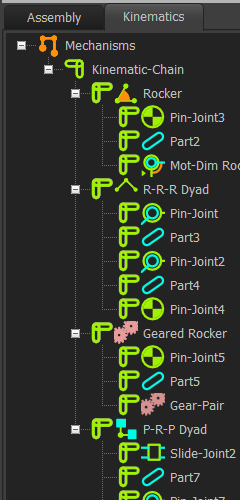Element-Explorer - Kinematics-Tree
See also: Kinematic-Symbols, and Configure-Power Source/ Change Dyad Closure
The Kinematics-Tree is the kinematic-structure of each kinematic-chain in the active Mechanism-Editor.
Note:
If you cannot explore the elements Kinematics-Tree , click Rebuild now.
We compile for you the Kinematic-Tree from the Kinematic and Machine elements that you add to your model.
If you click on any kinematic-chain, and then move your mouse to the graphics-area, the kinematic-chain show as the selected elements in the graphics-area.
You can right-click on any kinematic-chain to Configure the Power Source
Note: If you cannot see “Mechanisms”, or explore the Kinematics-Tree, click Rebuild now. The structure of the Kinematics-Tree is: ► Mechanisms: ► Kinematic-Chains ► Kinematic Sub-assemblies ► Kinematic Elements ►Unsolved Mechs
The Mobility of these kinematic-chains is zero(0). They are kinematically-defined (solved). You can explore the kinematic-chains to find Kinematic Sub-Assemblies and kinematic elements (see below)
These kinematic-chains have a mobility that is greater than zero(0). The kinematic-chains are not kinematically-defined. |
|||
 Example: Kinematics-Tree in Element-Explorer |
Kinematic-Sub-Assemblies (Solved Mechanisms ONLY): These are compiled as: a.Rockers b.Sliders 2.Dyads The type of Dyad is identified by its three joints, denoted with a letter: R = Revolute-Joint = Pin-Joint P = Prismatic-Joint = Slide-Joint S = Spherical-Joint = Ball-Joint a. R-R-R b. R-R-P c. R-P-R d. P-R-P e. R-P-P f. Ram-R g. Ram-P h. S-S-R i. S-S-P |
||